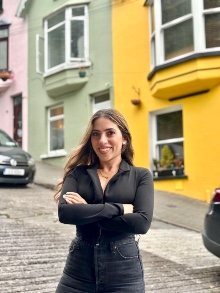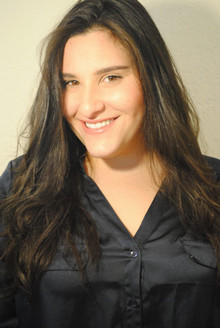Anna Simank '25, MA Student
Can you share a brief overview of your current research project(s) and its significance in communications studies? What overarching goals or objectives drive your current research?
I'm thrilled about my master’s thesis, which delves into a unique and underexplored area in communication studies. My project focuses on interviewing funeral home directors and morticians to understand how they use humor both within their organization and in their interpersonal interactions with coworkers. I believe this research has the potential to shed light on the often overlooked and stigmatized profession of funeral home workers by highlighting the crucial role they play in society. By examining how they cope with the constant exposure to death, I hope to reveal the ways humor serves as a tool to alleviate compassion fatigue and combat emotional burnout. Ultimately, this project aims to foster a deeper understanding and appreciation of funeral home workers’ resilience and the communicative strategies they employ to manage the demands of their vital work.
In what ways do you believe your current research contributes to advancements or addresses challenges within your field?
I believe my current research contributes to advancements in communication studies by addressing the unique communicative strategies used by funeral home professionals, a group often misunderstood or overlooked in academic research. By examining how morticians and funeral directors use humor to cope with the emotional challenges of their work, I aim to highlight the role of humor as a resilience-building tool within demanding, high-stress professions. This research addresses the broader challenge of understanding how individuals in emotionally taxing careers manage compassion fatigue and prevent burnout, and it offers valuable insights into how humor can support mental health and sustain professional dedication. Additionally, it helps demystify and destigmatize the funeral industry by humanizing its workers and emphasizing their essential role in supporting society during times of loss.
How have the research environment and resources at Texas A&M supported or influenced the direction of your work?
The research environment and resources at Texas A&M have profoundly influenced the direction and depth of my work, thanks to the guidance and encouragement of incredible mentors like Dr. Anna Wolfe and Dr. Nathan Crick. This project first emerged in Dr. Wolfe’s organizational communication course, where her insightful approach and enthusiasm for my idea helped shape it into a meaningful research endeavor. She has been a brilliant light throughout this entire process, supporting me through each question and challenge. Likewise, my advisor, Dr. Crick, has been invaluable, offering guidance at every step, from interview preparation to draft revisions. His consistent support and feedback have been instrumental in refining my work. I am extremely grateful to be part of a program where I am mentored by such supportive and prestigious faculty, who have been essential to my research journey.
Looking ahead, what are your aspirations for the future of your research, and are there specific areas or questions within your field that you hope to explore in your continued studies?
Looking ahead, I am excited to continue my journey into the field of interpersonal communication, as I am currently applying to doctoral programs with a strong emphasis on this area. My experience at Texas A&M has been instrumental in helping me discover my passion for both teaching and interpersonal research, and I’m eager to pursue these interests further. My ultimate goal is to study different forms of comedy—self-deprecating, dry humor, and beyond—and explore how these styles impact individuals’ personal and professional lives. I aspire to develop a course dedicated to the communication of comedy, where students can examine humor as a meaningful, multidimensional tool. In terms of research, I’m particularly interested in understanding how people use humor as a coping mechanism in the face of loss and adversity. By exploring these questions, I hope to contribute new insights into the ways humor fosters resilience and connection in challenging moments.
Nance Heise '27, PhD Student

Can you share a brief overview of your current research project(s) and its significance in communications studies? What overarching goals or objectives drive your current research?
My overarching research agenda is to engage knowledges in ways that move humanity ever so slightly closer to collective liberation. I work in the intersections between critical rhetoric, theory-informed history, and critical-cultural studies, and I have a deep commitment to justice and activist-oriented scholarship.
Most of my papers have been rhetoric-informed media criticism of popular culture texts. For example, I'll be presenting a critical analysis of the movie, Barbie at NCA this year. My newest work, though, focuses on hegemonic discourses espoused by The Church of Jesus Christ of Latter-day Saints and its leaders. At the Religious Communication Association pre-conference of NCA, I’ll present a still-in-progress piece that explores how the Church positions its organizational identity and women members’ identities. My most significant history work was about instances of witch hysteria in early America. In this ongoing project, one argument I make is that popular depictions of America's witch trials often leave out the colonial anxieties about indigeneity that played a large role in witch accusations across early America.
In what ways do you believe your current research contributes to advancements or addresses challenges within your field?
One challenge in the field of communication studies broadly—but rhetoric more specifically—is the propensity for minimizing the impact of race. I strive to not treat race as marginal but as an essential factor in understanding all socially constructed systems of power. I also hope to do the same with gender, class, and sexuality when appropriate.
I believe the humanities in general are moving towards a transdisciplinarity that I full-heartedly embrace. I particularly engage a critical-theoretical approach to historical research that is not “new” but does firmly place me in a liminal space, outside of history as a discipline but deeply tied to historians’ work.
How have the research environment and resources at Texas A&M supported or influenced the direction of your work?
The graduate student conference travel funding has given me access to a wider network of scholars, and that more than anything has influenced my work. My involvement with SSCA particularly has pushed me further and further towards rhetorical history, religion, and queer studies as many of my scholarly role models at that conference do work in those areas.
Looking ahead, what are your aspirations for the future of your research, and are there specific areas or questions within your field that you hope to explore in your continued studies?
My most important and seemingly far-off aspiration is to start growing my public scholarship. To get started, I’ve considered doing short-form video book summaries, accessible blog versions of my papers, or just posting small things more often on text-based social media platforms. I highly value accessible knowledge, and I really want to do something to make others’ work more accessible or to make my own research more public.
Outside of that, I have a growing interest in equitable education design in Communication Studies and beyond. In a short Teaching Activity piece that will be featured in the journal Feminist Pedagogy next year, Anum Ahmed and I explain a series of activities that instructors can use to build community and deepen discussion in their classrooms. Building a safe community space for students is just one way that instructors can create classrooms with critical feminist practice in mind.
Dissertation STARs
Yael Avnaim

Unveiling the Iconic: Exploring the Socio-cultural Impact of Touristic Photography on Social Medi
The proliferation of touristic photography on social media has given rise to iconic tourism photos with instant recognition and significant cultural impact. My dissertation delves into this phenomenon, focusing on Instagram as a key platform for disseminating these images. Using the "Deck of Cards" in Cobh, Ireland, as a case study, I explore how such iconic photos shape perceptions, influence tourist behaviors, and affect local communities.
The influx of tourists drawn by these iconic images has had mixed effects on Cobh. Increased visibility has boosted local tourism, bringing economic benefits. However, the surge in tourism has also led to noise, litter, and privacy invasions, prompting some residents to repaint their houses in less striking colors. This tension between visual appeal and residents' quality of life mirrors broader challenges tourist destinations face with the rise of the iconic touristic photo.
Through visual, rhetorical, and narrative analysis, my research examines the qualities that distinguish iconic tourism photos and their socio-cultural dynamics. By analyzing these photos' production and dissemination, I reveal their broader implications for media, economy, culture, and society. My methodology includes fieldwork, archival research, and spatial analysis, offering comprehensive insights into the intersection of photography, tourism, and cultural representation
Valentina Aduen

Legal Activism in Heirs’ Property Law Reform: A Legal Rhetorical Paradigm for Social Change
My dissertation studies the mobilization of personal and community narratives into the law. In order to trace how heirs’ property becomes a public problem I used engaged communication research methods to closely follow an heirs’ property case study and juxtapose with the movements happening in heirs’ property law reform. Two aspects of heirs property reform stand out in this study: 1) the history of racism that has both directly influenced the law and distorted its implementation, resulting in institutional structures that disadvantage specific populations, and 2) the rhetorical problem of how we get individuals to feel that they have a voice and can talk back to and engage with their problems. To engage with the history of heirs’ property, I use a theoretical frame of critical race theory (CRT) and legal realism, and ground my analysis with the case study of the Washington Estate Farm.
I collected, mapped and analyzed legal, environmental, oral, and historical data of the Washington Estate farm in Crockett, TX owned through heirs’ property; land passed through generations without a clear title. Heirs’ property is the most precarious form of land ownership in the United States and one of the main causes for land loss, including the loss of generational wealth, in this case, loss resulting from a predatory oil pipeline easement targeted at Black heirs’ property owners. Through participant observation, oral history interviews, place-based community (re)presentations and GIS (Geographic Information Systems) data I map and overlay landowners’ spatial stories, legal stories and oral traditions and history. In addition to lawyers’, activists’, practitioners’ and scholars’ (LAPS) stories as well as the stories that emerge in the overlay with traditional maps and collected GIS data points. With these methods I identify patterns that inform us of best practices for environmental planning and preservation with heirs’ property owners and am developing a case study format for recording descendants’ legal struggles regarding their land issues as a systematically recorded legal history. This work also informs us of ethical practices when working with communities with land at risk, including important considerations for multimodal research. Multimodal, because I filmed a documentary while conducting fieldwork and designed a strategic communication plan to present findings through a traditional written format, on social media and as a documentary film.
